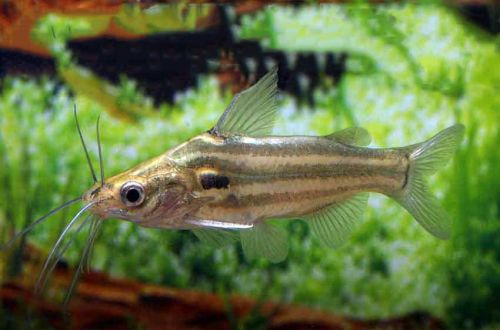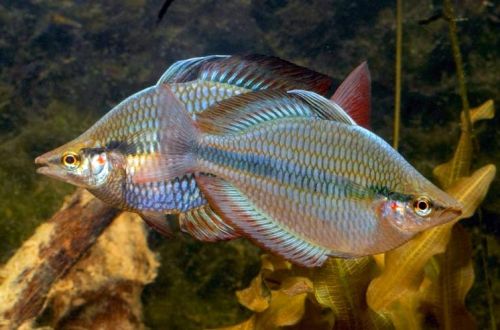
blue eyed neon
Pseudomugil blue-backed or Blue-eyed neon, scientific name Pseudomugil cyanodorsalis, belongs to the Pseudomugilidae family. Unusual universal tropical fish that can be used even in marine aquariums. Due to its ability to tolerate high concentrations of salt. Unpretentious and easy to maintain, has a peaceful disposition and beautiful coloring. May be recommended for beginner aquarists.

Contents
Habitat
Occurs from the northwestern and northern parts of the Australian continent. Some varieties of the species are also found in the southern part of New Guinea. Fish live in river deltas that flow into the ocean, coastal lagoons, mangrove swamps, and even in sea water near the coastline. Thanks to this, they acquired the ability to withstand significant fluctuations in salinity. The natural habitat usually does not have aquatic vegetation, but is areas of the same mangroves with a muddy bottom.
Brief information:
- The volume of the aquarium – from 40 liters.
- Temperature – 21-31°C
- Value pH — 7.0–8.0
- Water hardness – medium and high hardness (10-26 dGH)
- Substrate type – any
- Lighting – subdued / moderate
- Brackish water is permissible in a concentration of 1–10 g of salt per 1 liter of water
- Water movement – moderate
- The size of the fish is up to 3.5 cm.
- Food – any floating food, mostly meat
- Temperament – peaceful active
- Keeping in a flock of at least 8-10 individuals
Description
Adults reach a length of about 3.5 cm. The color of the body is bluish-yellow with a bright blue back, which in certain lighting gives a beautiful neon glow. The anal and dorsal fins are very elongated, the latter is located close to the tail. When they are raised, they outwardly begin to resemble a skirt. Males are somewhat larger and have longer fins than females.
Food
They feed closer to the surface. They accept all types of food (dry, live and frozen) of a suitable size. If possible, you should give preference to products such as small bloodworms, brine shrimp, daphnia.
Maintenance and care, arrangement of the aquarium
Aquarium sizes for a small group of Blue Eyed Neons start at 40 liters. The design is arbitrary and comes down to the personal preferences of the aquarist. However, it is recommended to use a sandy substrate that you can stick a few sticks into to simulate mangroves.
With regard to water parameters, there are several opinions regarding the question of whether to add salt or not. Long-term observations have shown that in brackish conditions, fish behave more energetically, life expectancy increases, and they are easier to breed. Therefore, the salt concentration in the range of 1–10 g per 1 liter of water is considered optimal.
In the process of keeping, saturation of the water with oxygen and the provision of an internal moderate current that simulates tidal waves are important. The aquarium should be equipped with a lid, as the fish can jump out of it.
Behavior and Compatibility
Calm and peaceful fish. Due to their small size, they are only compatible with species of comparable size. If the aquarium is brackish water, then the choice of neighbors will be very limited. The content in the group is at least 8–10 individuals of both sexes.
Breeding / breeding
Breeding is quite simple and does not require separate preparations. Spawning can occur at any time during the year. The impetus for the beginning of the mating season is the increase in temperature to the upper allowable values (28–30°C).
Females lay eggs among thickets of plants, attaching them with sticky threads. In a freshwater aquarium, small-leaved and low-growing species, such as Java moss, are best suited for this purpose. In brackish conditions, it is necessary to use artificial spawning plants (including homemade ones). The dominant male usually fertilizes several clutches from different females at once. Parental instincts are not developed; immediately after spawning, fish can eat their own eggs.
In order to preserve future offspring, fertilized eggs are timely transferred to a separate tank with identical water conditions. The fry will stay in it until they grow large enough (usually about six months). This separate tank is equipped with the same set of equipment as the main aquarium. The exception is the filtration system, in this case it is worth using a simple airlift filter with a sponge as a filter material. It will provide sufficient cleaning and avoid accidental suction of fry.
The incubation period lasts about 10 days, depending on the temperature. In the first days of life, micro-food (powdered) will be required. A week later, you can already serve Artemia nauplii.
Fish diseases
Health problems arise only in case of injuries or when kept in unsuitable conditions, which depresses the immune system and, as a result, provokes the occurrence of any disease. In the event of the appearance of the first symptoms, first of all, it is necessary to check the water for the excess of certain indicators or the presence of dangerous concentrations of toxic substances (nitrites, nitrates, ammonium, etc.). If deviations are found, bring all values back to normal and only then proceed with treatment. Read more about symptoms and treatments in the Aquarium Fish Diseases section.





